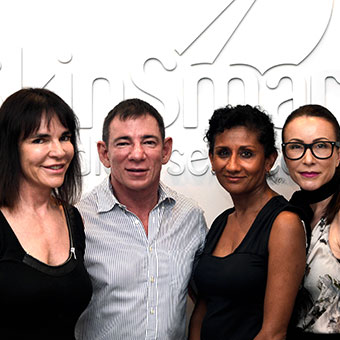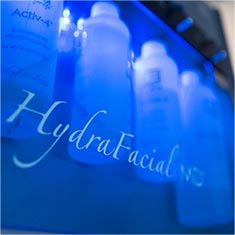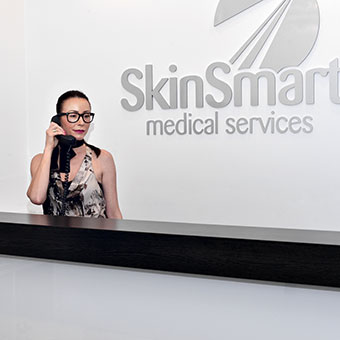Dermal Fillers
Introduction
Dermal Fillers are substances that can be injected into or just under the skin to treat lines and wrinkles or to restore lost volume and youthful contours to the face.
Dermal fillers are versatile substances and have many applications in cosmetic medicine and facial rejuvenation. There are many different dermal fillers available with differing properties that make some fillers better suited to certain applications than others.
Watch this short video on our injectable treatments
Description
There are 3 main classes of dermal filler used in cosmetic rejuvenation.
Volumising fillers. These produce an instant result by adding volume directly into the tissues or skin and then slowly breakdown over time leaving only minimal residual effect. Volumising dermal fillers work primarily by binding large amounts of water to themselves which they hold in the skin until the filler has broken down.
Stimulatory fillers. These trigger the body to produce collagen around the particles of filler causing the results to improve slowly over the weeks following the procedure and to persist for some time after the eventual breakdown of the filler particles due to the residual collagen left behind.
Permanent fillers. There is only one permanent filler available for use in Australia. Permanent fillers produce an immediate effect but don’t breakdown and will persist in the skin for many years without disappearing. While this may sound like a good idea at first it is worth remembering that the face changes gradually over time and the permanent filler may not remain in the optimal position as the person ages. Also once a permanent filler has been used in an area of the face no other type of filler can be injected into that area in the future due to potential incompatibility issues. This restricts the patient to using more of the original permanent filler in that area if further treatment is necessary in the future.
Applications
Dermal fillers can be used to rejuvenate the face in 3 basic ways.
Firstly thicker fillers can be injected underneath the skin into the subcutaneous tissues or below the muscles to replace lost volume and restore more youthful contours to the face. Examples of this would include the lips which can be re-inflated to their former glory with careful placement of small amounts of filler or the separations and troughs that occur in the mid face and temples as we age which can be filled in to produce a more youthful appearance.
Secondly moderately firm fillers can be injected into the skin itself underneath or across lines and wrinkles to fill these in or splint the skin to stop it creasing as much at that point. Examples of this would include treatment of the naso-labial folds below the nose or the marionette lines at the corners of the mouth.
Thirdly thinner fillers can be injected in sheets into or just under the skin to plump and strengthen the surface of the skin and function as a long-lasting injectable moisturiser. Examples of this would include the injection of a thin filler into the tissues of the lower cheeks to act as a skin booster or filler placed under the skin on the backs of the hands to plump and improve their appearance.
Preparation
The area to be treated should be clean and free from sunscreens and cosmetics and will be cleaned thoroughly prior to the procedure. The patient should be in good general health with no active infections and free of any major metabolic, autoimmune or neoplastic disease. The skin overlying the area to be injected should be healthy and free from irritations or infection.
The patient should avoid any medications, supplements or foods that are known to thin the blood and increase the risk of bruising for at least 10 days prior to the procedure. These include warfarin, aspirin and anti inflammatories such as Nurofen and Voltaren. Certain foods such as garlic and ginger and supplements such as fish oil, ginseng and ginkgo may also increase the risk of bruising.
Procedure
Dermal fillers can be injected into the skin in one of two ways.
Firstly a traditional sharp hypodermic needle can be used to inject the product. This has the advantage of being quick and accurate to use allowing the product to be placed exactly where it needs to go into or under the skin. The disadvantages of sharp needles are that they can more easily cause bruises by piercing structures under the skin and may be more painful for the patient.
Secondly a blunt cannula can be used to administer the product. This is done by making a small hole through the skin with a sharp introducer and then passing a long, blunt cannula through the skin into the loose connective tissue space underneath where it can be moved around to different locations on the face and the product injected as necessary. This has the advantage of causing less bruising and swelling as there are less entry wounds and less trauma to the tissues. It has the disadvantage that the product cannot be placed as accurately and can only be injected under the skin as the cannula is unable to penetrate into the skin itself. Often a combination of both techniques is used in the one patient.
Downtime
Some swelling and bruising of the injected area may occur after the procedure but usually subsides within a few days. Occasionally a bruise may persist for more than a week and require treatment with Hirudoid cream or laser to breakdown the old blood under the skin. Blood thinning medications such as Aspirin and anti inflammatories should be avoided for at least 10 days prior to the procedure to reduce the risks of bruising.
Ice packs, compression of the injected areas following treatment and elevation of the face at night with extra pillows under the head can all reduce the risks of swelling and bruising.
The injected areas may be tender to the touch for several days following the procedure but this should settle over about a week.
Risks
As with any medical procedure there are risks associated with the injection of dermal fillers. Some minor risks which are more common and some more serious risks which are much less common.
Immediately following the procedure minor risks include swelling, bleeding and bruising. These usually resolve quickly within a few days to a week.
Less commonly some fillers may form lumps under the skin and these may need to be treated with injections to dissolve them or break them up if they are worrying the patient or if they are visible through the skin.
Very rarely a lump of filler can form and become infected requiring antibiotic or anti-inflammatory treatment to settle it.
Most complications can be avoided by thorough patient preparation and good injecting technique.
Discomfort
As with any injection into the skin there can be some discomfort associated with dermal filler treatment. This is usually mild and transient however, and can be easily managed with simple measures such as local anaesthetic cream, applying ice to the skin prior to the procedure and laughing gas ( nitrous oxide ) if necessary. Most fillers are now formulated with local anaesthetic in the filler or can be mixed with local anaesthetic so that the area becomes progressively less sensitive as the treatment proceeds.
There may be some mild tenderness at the injected areas for a couple of days after the procedure but this should resolve quickly and is not usually an issue.
Aftercare
Following treatment with dermal fillers the patient should take it fairly easy for the rest of that day and then refrain from vigorous exercise for a couple of days. Ice may be applied to the area immediately after the treatment and intermittently for short periods throughout the day following the procedure to reduce swelling and bruising from developing. The night after the procedure the patient should sleep with their head elevated on a couple of pillows to reduce the accumulation of fluid that results from lying flat overnight. The area should be kept clean and the patient must refrain from touching or picking the injected areas for 48 hours after the procedure to reduce the risk of infection.
Bruising can be minimised or avoided completely by applying firm pressure to injection sites immediately following the injections, particularly if any bleeding is noted. If bruising does occur it can be treated with a heparinoid cream such as Hirudoid / Lasonil or hidden with coverup make up for a few days until it settles. Rarely some bruises may persist for over a week and these can be treated with laser/IPL to hasten the breakdown of the old blood in the skin.
Costs
Dermal fillers vary somewhat in cost and are charged by the volume of product used. Costs are therefore determined by the volume and type of filler used and the technical difficulty of the area being treated. Small amounts of filler used to treat a few lines around the mouth or re-inflate tired lips can be as little as a few hundred dollars while larger treatments such as cheek augmentation and ” liquid face lifts ” may cost substantially more depending on the amount of product used.



